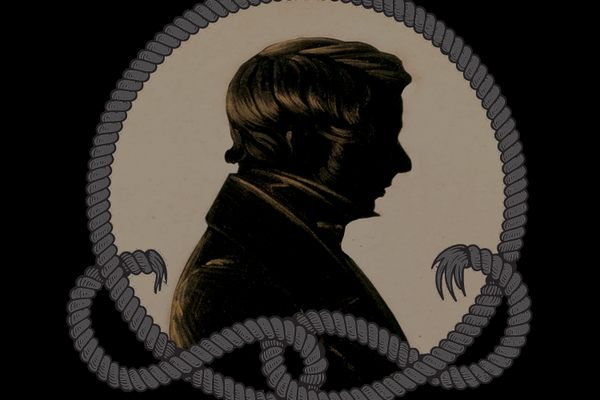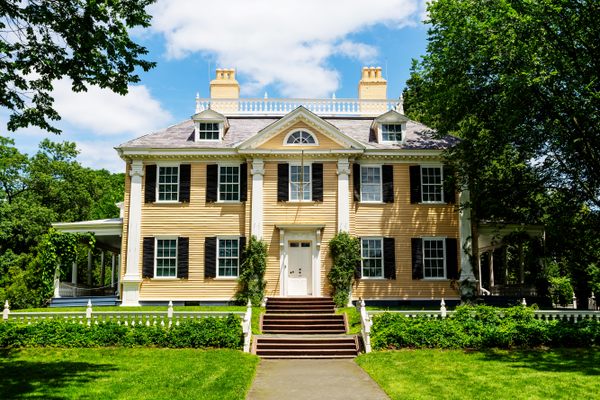The National Park That Was Stolen to Death
Fossil Cycad National Monument held America’s richest deposit of petrified cycadeoid plants, until it didn’t.

In 1933, a group of employees from the U.S. National Park Service found themselves in a bit of a pickle. The NPS was working hard to put together a display for the upcoming Chicago World’s Fair, a massive exhibition that promised to draw tens of millions of visitors. They already had a scale model of the Grand Canyon, wood samples from Petrified Forest, and a 12-foot-tall “miniature Mt. Rainer” that experienced a blizzard whenever visitors pushed a button.
But the director wanted to make sure they had something else—a fossilized cycad plant from the end of the Cretaceous period. Thousands had been preserved in the silt beds of South Dakota, and the best specimens were both familiar-looking and clearly ancient. If you were showing off the country’s wonders, a cycad was a good thing to include.
The staffers figured they knew where to find one: at Fossil Cycad National Monument, a 320-acre patch of land in South Dakota’s Black Hills, just south of Minnekahta. After all, it had been set aside for protection because it was littered with the things. But when they returned, they were empty-handed: not only did they fail to bring back a suitable specimen, they couldn’t even suss out where to look for one. “They came back and said they couldn’t find the site,” says Vince Santucci. “There were no resources left at the location.”


Santucci, a senior paleontologist with the National Park Service, is used to digging up and piecing together lost creatures. He’s spent the past few decades reconstructing a different kind of extinct thing: the lost saga of Fossil Cycad. One of only a few national monuments in U.S. history to be completely stripped of its status, the site—which started out as a trove of ancient treasures—eventually became the center of political skirmishes, dramatic staged excavations, everyday pilfering, and scientific self-sabotage. “An incredible story emerged,” says Santucci.
The tale of Fossil Cycad really starts in the late Cretaceous, when a large clump of prehistoric plants in what would eventually become the Black Hills was buried by a landslide. Over the next 70 million years, the plants slowly solidified, as their organic matter was replaced with built-up molecules of silica and other minerals. In the 1890s, South Dakota ranchers began discovering the resulting fossils in great numbers, nicknaming them “petrified pineapples” and selling them as curios.
Soon, scientists from the University of Iowa, the Smithsonian, and other institutions came out to investigate, and to buy specimens. The fossils were preserved to a unique degree, enabling researchers to dissect and study them almost as they would a living plant. (As Santucci explains, they were also actually cycadeoids, which have different reproductive structures than cycads—but this distinction was not made until later.) By the end of the 19th century, the land around Minnekahta was recognized as a unique and significant paleontological site.

One of these scientists was a young man named George Reber Wieland. A paleontology student at Yale University, Wieland had spent the beginning of his career chasing down dead animals, gaining a certain amount of renown for his discovery of Archelon ischyros, a Cretaceous-era sea turtle that remains the largest known to man.
In 1898, the year after he dug up the turtle, Wieland went to the Black Hills and found something that interested him even more: a fossil cycad, with what he later described as “the most perfectly silicified prefoliate fronds of any yet obtained.” He changed his focus to paleobotany, and embarked on a mission to achieve “a complete elaboration” of the structures of various cycad types.
“He became the world’s leading expert on fossil cycads,” says Santucci, who describes Wieland as “sort of an eccentric, crazy professor.” He wrote two books on the subject, American Fossil Cycads and American Fossil Cycads, Volume 2, in which he wrote rapturously of the “superb beauty” of particular cycads while laying out their anatomy and natural history. He even decorated his backyard with some of his specimens, arranged alongside living plants.

All this time, Wieland was also working on a related side project: trying to protect the fossil-rich area in South Dakota from which so many of his beloved specimens came. There were layers upon layers of the so-called petrified pineapples hidden in the dirt, but thanks to the attentions of collectors, tourists, and scientists like himself, they tended to disappear nearly as fast as erosion revealed them. This was, Wieland had written, “the most important of all the American cycad horizons.” Was there some way to keep it intact?
In 1906, Theodore Roosevelt gave him a possible way forward by passing the Antiquities Act, which granted presidents the power to designate federal lands as national monuments. Roosevelt quickly began using it, setting aside spaces including Devil’s Tower, Montezuma Castle, and the Muir Woods. “Wieland strongly felt that the site that he was working on was worthy of similar preservation,” and began lobbying the government to turn it into a national monument, says Santucci. “He invested a lot of energy.” During his research, Santucci found copies of dozens of letters the professor wrote to senators and Congressmen, asking for their support.
When that proved ineffective, Wieland dreamed up a different strategy. In 1920, under the auspices of the Homesteading Act—which was more meant to encourage people to move West, not to enable paleobotany—“he actually acquired 160 acres of land in which the fossils were situated,” says Santucci. “So he was using that as leverage, convincing the federal government that he would donate it back.”

This worked. On October 21, 1922, President Warren G. Harding officially deemed the area protected, placing it under the jurisdiction of the U.S. National Park Service. The paleobotanic deposits at the newly declared Fossil Cycad National Monument were “of great scientific interest and value,” Harding wrote in the corresponding Presidental Proclamation. “Warning is hereby expressly given to all unauthorized persons not to appropriate, injure, destroy, or remove any of the fossils of this monument.”
Unfortunately for Fossil Cycad, its official recognition as an American landmark came at a difficult time for the country overall. “It was a period of economic hardship,” says Santucci. “Fossil Cycad wasn’t really developed like other national parks and monuments were.” That meant no one was hired to watch over the land. While the superintendent of nearby Wind Cave National Park was put in charge of its overall management, “day-to-day surveillance was entrusted to local ranchers,” writes Santucci. The site’s only sign—a 15-inch carved wooden plank—abbreviated both “National” and “Monument,” but made sure to spell out “NO PROSPECTING.”
Despite this lack of amenities, tourists continued to swing by, and to take pieces of the monument home with them. “People reading in newspapers about the monument in the Black Hills would come,” says Santucci. Natural erosion meant that new layers of fossils were gradually exposed, creating more buzz and more foot traffic. Such was the Fossil Cycad catch-22: when there weren’t any visible fossils, it wasn’t much of a monument. But whenever there were enough to attract visitors, those same visitors meant they were quick to disappear.

This cycle happened repeatedly. When the National Park Service sent the superintendent of Yellowstone to check on Fossil Cycad in 1929, he didn’t mince words. “There is nothing left that is of interest to visitors,” he wrote in his report. Pointing out that the NPS had a reputation to uphold, he continued, “It is a liability, not an asset, to the rest of the system… it would seem to be desirable to discontinue it as a national monument.”
For years, government authorities argued back and forth about whether to keep Fossil Cycad on the payroll. Meanwhile, Wieland wasn’t one to sit on his hands. In 1935, after the World’s Fair debacle, he brought a crew from the Civilian Conservation Corps to Fossil Cycad. As scientists and NPS representatives looked on, the workers dug a half dozen pits, revealing piles upon piles of previously unexposed fossils, over one ton of material.
Wieland had the fossils stored in Wind Park for safekeeping, but when the NPS asked him to write a report detailing the site’s precise value, he said he wouldn’t do any more work until they had committed to building some infrastructure. Specifically, he wanted a black granite museum where he could display his most interesting specimens.

The NPS called his bluff, suggesting that Wieland seek his own funding, and sending him once again into what Santucci calls “a frenzy of letter-writing” to various politicians. He began agitating for a visitor’s center as well, asking students at the Yale School of Architecture to draft design proposals, and trying to convince his own senator to earmark the cost into the Connecticut state budget. (He said no.)
In the meantime, others related to the endeavor began to call Wieland’s integrity into question. In 1938, the superintendent of Wind Cave National Park, E.D. Freeland, told the South Dakota Argus-Leader that on several occasions, Wieland had had “carloads” of fossil cycads shipped to New Haven, both from the site itself and from the “protected” stash stored at Wind Cave.
“There is not one specimen at the Wind Cave national park, where every day interested visitors inquire about them,” Freeland said at the time. (As Santucci writes, National Park Service geologist Carrol Wegemann corroborated the claim, and Wieland later admitted to having stolen at least 1,000 specimens right before the monument was designated.)

Facing these accusations—and, one suspects, the prospect of having doomed his own monument—Wieland became more and more agitated. He responded to a proposal to build a cycad-related visitor’s center at Wind Cave instead as full of “bat dung,” arguing somewhat ironically that the fossils must be viewed “in situ,” or the site would “mean but little.” He called Freeland a “hill billy,” and referred to his park as “Windy Cave.” “You have stood my good plans off for fifteen years,” he wrote desperately to the NPS.
It was all for naught. Wieland died in 1953, and four years later, the monument—which by now just looked like grass, rocks and dirt—was officially abolished.
It has left one legacy, though. Fossil theft is still a big problem in national parks. “Over the past ten years, we have had more than 700 documented instances,” Santucci says.
Having pieced together this story, in which such transgressions were taken to extremes, he’s since been working its lessons into educational programs. “People are incensed to think that an area that was set aside as a National Park is no longer there,” he says. “The circumstances upon which that decision was made, to abolish it—I think it does help us to present the idea that fossils are non-renewable resources.” We’ve already learned that the hard way.



















Follow us on Twitter to get the latest on the world's hidden wonders.
Like us on Facebook to get the latest on the world's hidden wonders.
Follow us on Twitter Like us on Facebook